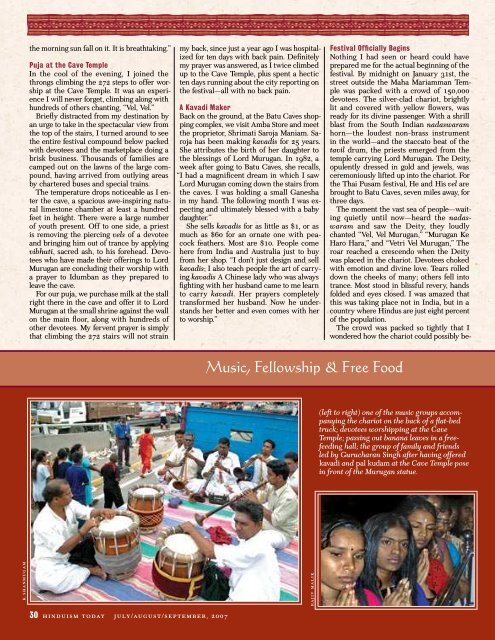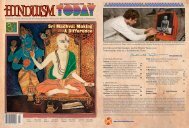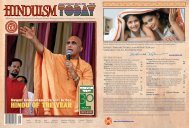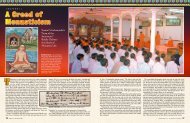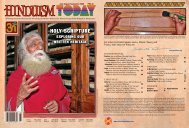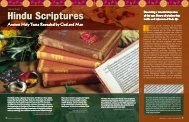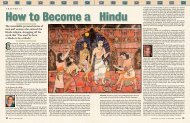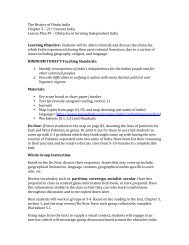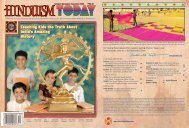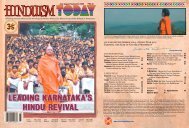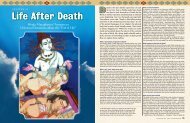Hinduism Today July 2007 - Cover, Index, Gatefold, Front Articles
Hinduism Today July 2007 - Cover, Index, Gatefold, Front Articles
Hinduism Today July 2007 - Cover, Index, Gatefold, Front Articles
Create successful ePaper yourself
Turn your PDF publications into a flip-book with our unique Google optimized e-Paper software.
the morning sun fall on it. It is breathtaking.”<br />
Puja at the Cave Temple<br />
In the cool of the evening, I joined the<br />
throngs climbing the 272 steps to offer worship<br />
at the Cave Temple. It was an experience<br />
I will never forget, climbing along with<br />
hundreds of others chanting, “Vel, Vel.”<br />
Briefly distracted from my destination by<br />
an urge to take in the spectacular view from<br />
the top of the stairs, I turned around to see<br />
the entire festival compound below packed<br />
with devotees and the marketplace doing a<br />
brisk business. Thousands of families are<br />
camped out on the lawns of the large compound,<br />
having arrived from outlying areas<br />
by chartered buses and special trains.<br />
The temperature drops noticeable as I enter<br />
the cave, a spacious awe-inspiring natural<br />
limestone chamber at least a hundred<br />
feet in height. There were a large number<br />
of youth present. Off to one side, a priest<br />
is removing the piercing vels of a devotee<br />
and bringing him out of trance by applying<br />
vibhuti, sacred ash, to his forehead. Devotees<br />
who have made their offerings to Lord<br />
Murugan are concluding their worship with<br />
a prayer to Idumban as they prepared to<br />
leave the cave.<br />
For our puja, we purchase milk at the stall<br />
right there in the cave and offer it to Lord<br />
Murugan at the small shrine against the wall<br />
on the main floor, along with hundreds of<br />
other devotees. My fervent prayer is simply<br />
that climbing the 272 stairs will not strain<br />
my back, since just a year ago I was hospitalized<br />
for ten days with back pain. Definitely<br />
my prayer was answered, as I twice climbed<br />
up to the Cave Temple, plus spent a hectic<br />
ten days running about the city reporting on<br />
the festival—all with no back pain.<br />
A Kavadi Maker<br />
Back on the ground, at the Batu Caves shopping<br />
complex, we visit Amba Store and meet<br />
the proprietor, Shrimati Saroja Maniam. Saroja<br />
has been making kavadis for 25 years.<br />
She attributes the birth of her daughter to<br />
the blessings of Lord Murugan. In 1982, a<br />
week after going to Batu Caves, she recalls,<br />
“I had a magnificent dream in which I saw<br />
Lord Murugan coming down the stairs from<br />
the caves. I was holding a small Ganesha<br />
in my hand. The following month I was expecting<br />
and ultimately blessed with a baby<br />
daughter.”<br />
She sells kavadis for as little as $1, or as<br />
much as $60 for an ornate one with peacock<br />
feathers. Most are $10. People come<br />
here from India and Australia just to buy<br />
from her shop. “I don’t just design and sell<br />
kavadis; I also teach people the art of carrying<br />
kavadis A Chinese lady who was always<br />
fighting with her husband came to me learn<br />
to carry kavadi. Her prayers completely<br />
transformed her husband. Now he understands<br />
her better and even comes with her<br />
to worship.”<br />
Festival Officially Begins<br />
Nothing I had seen or heard could have<br />
prepared me for the actual beginning of the<br />
festival. By midnight on January 31st, the<br />
street outside the Maha Mariamman Temple<br />
was packed with a crowd of 150,000<br />
devotees. The silver-clad chariot, brightly<br />
lit and covered with yellow flowers, was<br />
ready for its divine passenger. With a shrill<br />
blast from the South Indian nadaswaram<br />
horn—the loudest non-brass instrument<br />
in the world—and the staccato beat of the<br />
tavil drum, the priests emerged from the<br />
temple carrying Lord Murugan. The Deity,<br />
opulently dressed in gold and jewels, was<br />
ceremoniously lifted up into the chariot. For<br />
the Thai Pusam festival, He and His vel are<br />
brought to Batu Caves, seven miles away, for<br />
three days.<br />
The moment the vast sea of people—waiting<br />
quietly until now—heard the nadaswaram<br />
and saw the Deity, they loudly<br />
chanted “Vel, Vel Murugan,” “Murugan Ke<br />
Haro Hara,” and “Vetri Vel Murugan,” The<br />
roar reached a crescendo when the Deity<br />
was placed in the chariot. Devotees choked<br />
with emotion and divine love. Tears rolled<br />
down the cheeks of many; others fell into<br />
trance. Most stood in blissful revery, hands<br />
folded and eyes closed. I was amazed that<br />
this was taking place not in India, but in a<br />
country where Hindus are just eight percent<br />
of the population.<br />
The crowd was packed so tightly that I<br />
wondered how the chariot could possibly begin<br />
its journey. I could not even budge from<br />
where I was standing. But when the clock<br />
struck 12:20 am, the pilot car started up,<br />
the chariot began to move and the crowed<br />
swiftly parted and the bhajanas abruptly<br />
stopped. Strategically-placed volunteers politely<br />
directed people to make way. Trailing<br />
behind was a large generator that powered<br />
the multitude of lights. Next came the police<br />
and ambulance service. Security was<br />
strong, I was told, to avoid any interference<br />
by trouble-makers. A dozen or more police<br />
walked directly behind the chariot to keep<br />
devotees back a few feet. Until a few years<br />
ago, the chariot was pulled by the devotees<br />
with the help of oxen; but this practice was<br />
discontinued in favor of a vehicle.<br />
On the Chariot’s Route<br />
Preceding the pilot car a large crane truck<br />
operated by the electrical supply company<br />
lifts overhead wires out of the way of the 21-<br />
foot-tall chariot; others are cut outright and<br />
reconnected after the chariot has passed—<br />
leaving the surrounding area in temporary<br />
darkness. Overpasses (“flyovers,” as they<br />
are called here) enroute have been built<br />
high. One flyover is engineered to be raised<br />
when the chariot comes through.<br />
As the chariot presses forward, the crowd<br />
swells with people coming in from all directions.<br />
In the procession behind, a powerful<br />
rhythm is kept by bhajan groups, musicians<br />
and kolattam dancers. Kolattam, akin to the<br />
North Indian garba dance, is performed<br />
with sticks in a circle. Groups of musicians<br />
summon devotees to the street and intensify<br />
the sense of anticipation by conducting bhajans<br />
several blocks ahead of the chariot, then<br />
move further ahead when the chariot comes<br />
into view. I am reminded of joyous scenes<br />
on the streets of Delhi when thousands of<br />
marriages take place on certain nights due<br />
to the auspicious configuration of planets.<br />
Devotees line the entire route, holding<br />
trays of bananas, coconuts, camphor, joss<br />
stick incense and clothing they will offer to<br />
Lord Murugan. Many break a coconut, then<br />
put camphor on one half and hand it up to<br />
the priests to wave as light before the Deity.<br />
Parents hand up babies to be blessed—at<br />
some stops, by the dozen. Those managing<br />
the chariot allow time for everyone to<br />
worship at each stop. At several locations,<br />
groups of people break hundreds of coconuts<br />
on the street—something I have never<br />
seen in India. With devotees in a long queue<br />
for archana and holding their babies to be<br />
blessed, suddenly a resounding “crack!” is<br />
heard as a dozen people threw coconuts<br />
down on the concrete road simultaneously.<br />
Piles of broken coconuts come up in a matter<br />
of minutes. This is a controversial practice,<br />
I learned, that some devotees are quite<br />
taken aback by. I was told that at least the<br />
coconuts do not go to waste, but are used in<br />
oil production.<br />
I took it as a blessing from Lord Murugan<br />
Himself that the chariot passed right in<br />
front of my hotel at about 3 am, allowing me<br />
to unobtrusively leave the procession to seek<br />
a few hours’ rest, knowing I would be spending<br />
the afternoon and evening at Batu Caves.<br />
However, thousands of devotees followed<br />
the chariot all the way to its destination.<br />
Arriving at Batu Caves<br />
Moving at a snail’s pace, the chariot arrived at<br />
Batu Caves at 11:30 am, covering the seven<br />
miles from the temple in twelve hours. With<br />
horns and conches blaring, bells ringing,<br />
chants resounding and arati lamps raised in<br />
fervent puja, the Murugan Deity was ceremoniously<br />
installed in the New Swami Mandapam<br />
at the foot of the hill. His golden vel<br />
was carried to the Cave Temple by the head<br />
priest. The festival officially began with the<br />
flag raising, which was scheduled for 4 pm,<br />
but actually occurred at 5:30. At this auspicious<br />
even, I had the honor of briefly meeting<br />
Dr. K. Pichai Sivachariyar, <strong>Hinduism</strong><br />
<strong>Today</strong>’s Hindu of the Year for 2004 (www.<br />
hinduismtoday.com/archives/2004/10-12/<br />
40_honor.shtml) and one of the foremost<br />
priests of South India. He was there with a<br />
contingent of Indian brahmins brought in to<br />
help with the festival.<br />
During Thai Pusam, the wide concrete<br />
path to the cave is divided into two sections,<br />
one for those entering and one for those<br />
leaving. The flag-hoisting ceremony takes<br />
place on the exit side, next to the holy spear<br />
of Lord Murugan—which nearly matches<br />
the height of the His golden statue.<br />
Every inch of the compound was packed<br />
Music, Fellowship & Free Food<br />
(left to right) one of the music groups accompanying<br />
the chariot on the back of a flat-bed<br />
truck; devotees worshipping at the Cave<br />
Temple; passing out banana leaves in a freefeeding<br />
hall; the group of family and friends<br />
led by Gurucharan Singh after having offered<br />
kavadi and pal kudam at the Cave Temple pose<br />
in front of the Murugan statue.<br />
k.shanmugam<br />
r ajiv malik<br />
k.shanmugam<br />
r ajiv malik<br />
30 hinduism today july/august/september, <strong>2007</strong> july/august/september, <strong>2007</strong> h i n d u i s m t o d ay 31


